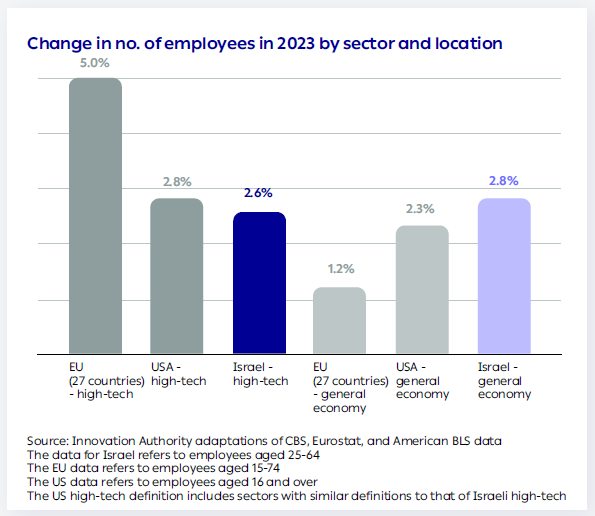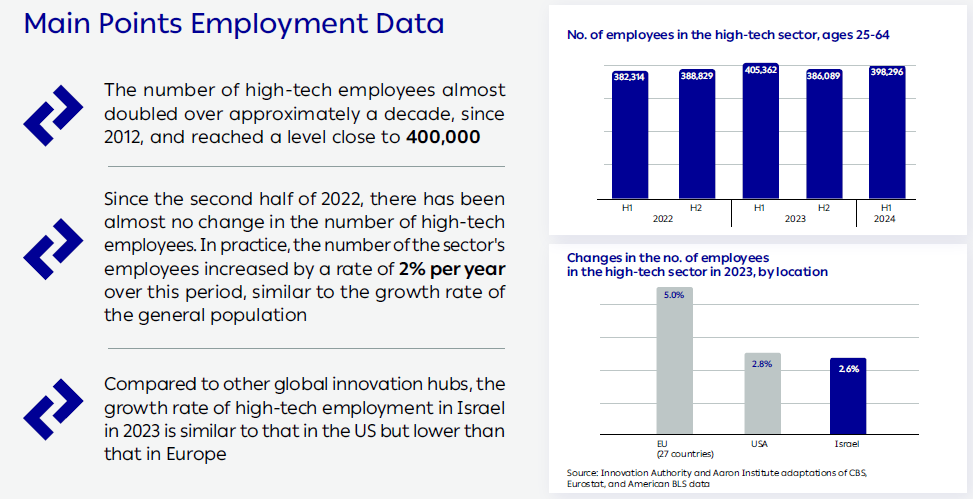
Employees: Stagnation in High-Tech Employment Over the Past Two Years
In terms of the Israeli economy, high-tech’s significant contribution to the economy depends on employment in the sector. The changes related to this metric are therefore fundamental for the future of the economy. Between 2012-2022, high-tech doubled in size in terms of employees whose numbers reached approximately 400,000. In other words, the long-term trend was one of growth in high-tech employment. Since 2022, however, there has been almost no change in the number of high-tech employees.
The stagnation in the number of high-tech employees over the past two and a half years has also led to a curbing in the growth of high-tech’s relative share of employment in Israel that has remained almost steady at 11% since the second half of 2021. This comes after a decade when high-tech’s relative share rose from less than 8% to over 11%.

The Number of High-Tech Employees Has Grown Since the Beginning of the War
An examination of the rate of change in the number of high-tech employees from the fourth quarter of 2023 to the end of mid-2024 i.e., the period of the war, reveals that the number of high-tech employees increased by about 25,000, an increase of 3.8% compared to the same period last year. In contrast, examining the war’s influence on employment in the economy’s other sectors during this period reveals an increase of 1.1%. Nevertheless, it is important to emphasize that this increase comes after a significant decline in high-tech employment during the third quarter of 2023, so that over the past year, the number of high-tech employees has actually declined. The reasons for the decline in the third quarter of 2023 are being analyzed.
It should be noted that, as of now, the data does not indicate a growth in employment in the defense technology companies in Israel, despite Israel’s increased defense and security needs during this period.
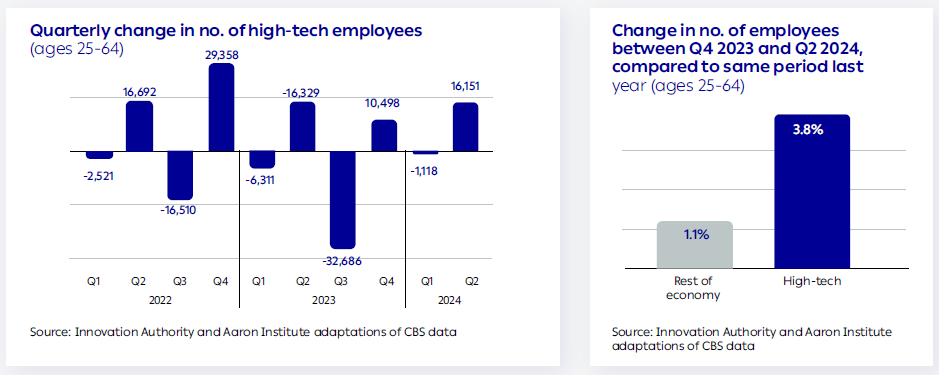
The Growth in the High-Tech Sector Since October 7: Only in R&D Jobs
A more in-depth examination of the composition of high-tech employees according to the different fields reveals that for nearly six consecutive quarters, there was a decline in the number of employees in product and administrative jobs in the high-tech sector. In other words, the field of employment continuing to demonstrate growth in high-tech is almost exclusively in R&D (research and development) jobs. This reality necessitates continued monitoring to clarify the reasons for the decline – a reduction in the number of jobs for cost reduction purposes, jobs leaving Israel, technological changes, or other reasons.
Consequently, in the first half of 2024, the ratio of R&D employees exceeded more than half the total number of high-tech employees. In other words, high-tech is increasingly focusing on development roles while the other jobs – some of which have lower entry barriers because they do not require technology training – are gradually declining.

The Demand for High-Tech Employees Has Been Almost Unaffected by the War
The number of available jobs in the high-tech sector is a metric that reflects the jobs opened and advertised by the companies and the demand for employees. When examining this metric today, it is obvious that a certain downturn occurred with the outbreak of the war and that the number of available jobs in high-tech declined, especially in hightech services (software). However, the first quarter of 2024 recorded a recovery and the number of available jobs in high-tech services companies increased once again to pre-war levels. The war did not therefore have an influence on available jobs except in the quarter in which it began.
Following a sharp increase in the number of available jobs in services companies that began in 2020 and reached its peak at the end of 2021, since the beginning of 2023, the number of available jobs has been cut by half and settled on 10,000-11,000 available jobs per quarter, similar to the figure that characterized the sector in 2018, as presented in the Innovation Authority’s annual report.
Despite media reports of an increase in demands of defense technology companies, thus far, there has been no obvious change in the number of available jobs in the high-tech sector (including defense industry companies), and it appears less volatile and sensitive to market changes, and characterized by stagnation.
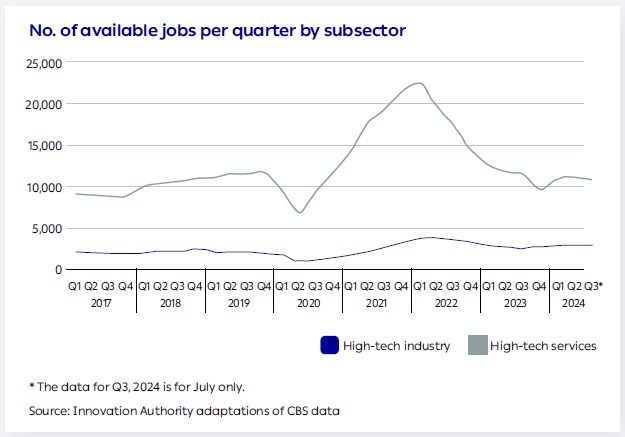
High-tech Salaries Continue to Increase
While the growth in high-tech employment has been curbed since 2022, salaries in the sector have continued to rise, even during the period of the war. During the second quarter of 2024, the average high-tech salary stood at 31,500 shekels. This, while the economy’s average salary stood at 11,300 shekels. Since the beginning of the war, high-tech salaries have increased by an average of 5.5% whereas salaries in the rest of the economy rose by only 2%. As a result, the gap between salaries in the high-tech sector and the rest of the economy continued to grow and the ratio between them stood at 2.8 times higher in the last quarter.
Nevertheless, the rate of salary growth within the high-tech sector varied between different fields. While salaries in the high-tech industries subsector registered an increase of 11% in relation to salaries in the quarter preceding the war and reached 29,500 shekels, salaries in the high-tech services subsector i.e., software, increased by only 3.6% to 32,200 shekels.
Looking forward at the high-tech companies’ expectations regarding salary increases in the sector, according to the CBS survey of business managers’ expectations conducted in July 2024, 56% of the high-tech industries companies expect a salary increase in the coming year. This contrasts with 33% of the hightech services companies. The figure for the high-tech services companies is the lowest observed since the survey began in its current form in July 2022.
Another characteristic of salaries in the high-tech sector worthy of mention is its’ seasonality. As can be seen in the diagram, in the first quarter of the year, high-tech salaries tend to increase markedly and decline again in the following quarters. This phenomenon can be explained primarily by the payment of yearly bonuses typical of the sector.
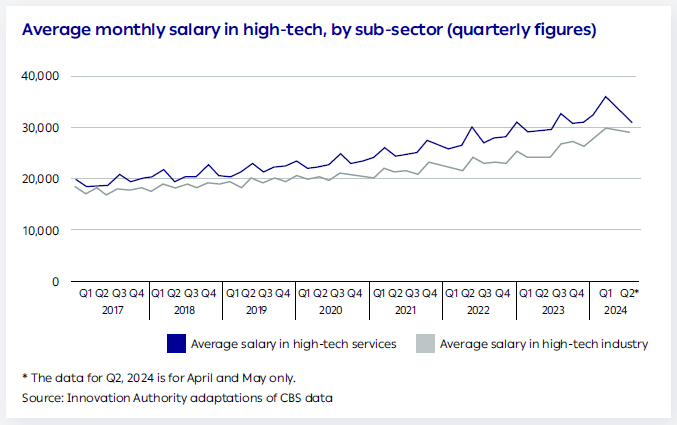
High-Tech Companies are More Optimistic About Hiring Employees
An examination of high-tech services companies’ expectations about hiring employees in the coming year reveals that as of July 2024, about nine months since the outbreak of the war, almost one-quarter (23%) of the companies reported in the CBS survey of business managers’ expectations conducted in July 2024 that they expect an increase in their companies’ hiring of employees in the coming year.
In contrast, 20% of the companies expected a decline and 46% of the companies expected no change in the hiring of new employees. These figures reflect that in 2024 there is a less pessimistic atmosphere in the high-tech services companies than that recorded in the survey of July 2023. A year ago, only 10% of the high-tech services companies expected an increase in the hiring of employees, whereas 35% expected a decline. In other words, in 2024, there was an increase in expectations regarding the hiring of new employees and a decline in the expectation of reduced hiring of employees compared to expectations in 2023.
Furthermore, the optimism in the high-tech companies is greater than that in the services companies in the economy’s other sectors, where only 10% expect an increase in the hiring of employees.
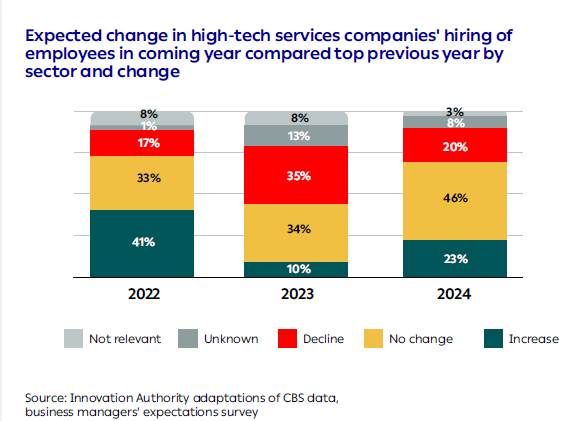
These figures do not relate to the location of the employees hired – Israel or overseas – and it is important to continue monitoring this factor, which will influence the sector’s development. Moreover, this survey did not check the different jobs to which employees are expected to be hired, and the past year’s employment data reveals a decline in the hiring of employees for non-technology jobs.
Growth in High-Tech Employment in 2023 Was Similar to the US and Lower than Europe
As a sector influenced by global economic trends, it is important to compare the Israeli high-tech metrics to those in other global innovation hubs which are impacted by the same trends and are also contending with a crisis since 2022. Over the past two years, local events have also occurred in Israel that influence the economy and the high-tech sector. A comparison was therefore made of the change in high-tech employment in Israel and in other global hubs, and also of the change in high-tech employment in Israel in relation to the other sectors of the Israeli economy.
The comparison reveals that in 2023 (the last year for which there is available data for enabling a global comparison), the first signs of recovery and emergence from the crisis were registered in the EU, where high-tech employment increased 5%. In other words, in the countries of the EU, the high-tech sector increased its centrality to the local economy. In the US, high-tech employment grew by 2.8% in 2023 – a level similar to that in Israel (2.6%). With the publication of data for 2024 in the international databases, it will be possible to check the influences of the war on employment in the Israeli high-tech sector in global terms.
In general, the rate of growth in high-tech employment is higher than that in the economy’s other sectors. As evidence, the employment growth rate in the general EU economy in 2023 was 1.2% and in the US 2.3% i.e., lower than the growth in high-tech in both locations. In contrast, in Israel, employment in the general economy grew by a slightly higher rate than in high-tech (2.8%).
